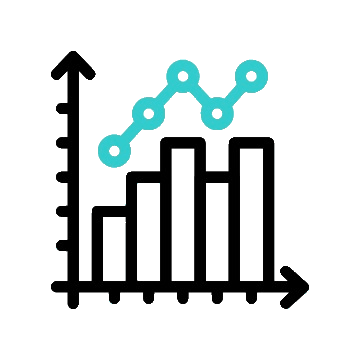DATA SCIENCE
using PYTHON
LIVE ONLINE TRAININGGeneralized Autoregressive Conditional Heteroskedasticity (GARCH) Model
GARCH is a method for calculating market volatility. Financial organizations utilize the model to determine the return volatility of stocks, bonds, and other investment vehicles. When forecasting the values and rates of financial instruments, the GARCH process gives a more realistic backdrop than other models.
GARCH model is the extension of ARCH model as follow:
- Var(ût) = σ2t = β0 + β1 û2t - 1 + β2 σ2t - 1 + …… + βp û2t – p + βq σ2t – q
Here, σ2t is a function of lagged squared error term û2 as well as lagged σ2t
It is denoted by GARCH(p,q) where p is lagged error term and q is lagged variance. Lagged terms are added based on AIC, BIC, test of significance and so on.
GARCH(1,1) model is similar to ARCH(2) model and GARCH(p,q) model is similar to ARCH(p+q) model.
I implemented the GARCH Model to model the US/UK Foreign Exchange Rate data and GARCH(1,1) is not significant. GARCH(1,0) is significant which is equivalent to ARCH(1) model.
import numpy as np
import pandas as pd
import matplotlib.pyplot as plt
import seaborn as sns
import math
# Load the input files
us_uk_fx_rates = pd.read_excel("./Data/US_UK_Foreign_ Exchange_Rate.xls", sheet_name = "Data"
us_uk_fx_rates.head()
| Date | us_uk_fx_rates | |
|---|---|---|
| 0 | 1973-01-01 | 2.36 |
| 1 | 1973-02-01 | 2.43 |
| 2 | 1973-03-01 | 2.47 |
| 3 | 1973-04-01 | 2.48 |
| 4 | 1973-05-01 | 2.53 |
In the dynamic world of financial markets and economic indicators, one feature remains consistent: volatility is never constant. Financial time series often exhibit periods of intense market movement, followed by calmer phases. This phenomenon, known as volatility clustering, cannot be effectively captured by simple models that assume constant variance.
The Generalized Autoregressive Conditional Heteroskedasticity (GARCH) model was introduced — a cornerstone in financial econometrics and time series forecasting.
The GARCH model, developed by Tim Bollerslev in 1986, is an extension of the ARCH (Autoregressive Conditional Heteroskedasticity) model introduced by Robert Engle in 1982. These models are designed to analyze and forecast time series data where the variance changes over time, especially in response to past events.
In simple terms, GARCH allows you to model the volatility of a variable (like stock returns) over time, accounting for the fact that today’s volatility may depend on both yesterday’s volatility and the size of previous shocks.
GARCH is a statistical model that can be used to analyse a number of different types of financial data, for instance, macroeconomic data. Financial institutions typically use this model to estimate the volatility of returns for stocks, bonds and market indices.
GARCH models describe financial markets in which volatility can change, becoming more volatile during periods of financial crises or world events and less volatile during periods of relative calm and steady economic growth.
From arch as arch_model
data = us_uk_fx_rates.us_uk_fx_rates.values
model = arch_model(data, p = 1, q = 1, vol = "GARCH").fit()
model
| Iteration: 1, Func. Count: 6, Neg. LLF: -6.68398068169715 |
| Iteration: 2, Func. Count: 18, Neg. LLF: -21.908071990621252 |
| Iteration: 3, Func. Count: 25, Neg. LLF: -32.03648450109571 |
| Iteration: 4, Func. Count: 31, Neg. LLF: -55.846232439431915 |
| Iteration: 5, Func. Count: 39, Neg. LLF: -62.00629943841792 |
| Iteration: 6, Func. Count: 46, Neg. LLF: -64.02116623027486 |
| Iteration: 7, Func. Count: 53, Neg. LLF: -67.5126947148861 |
| Iteration: 8, Func. Count: 61, Neg. LLF: -69.10071398565478 |
| Iteration: 9, Func. Count: 69, Neg. LLF: -69.12731316725817 |
| Iteration: 10, Func. Count: 76, Neg. LLF: -69.98328665858482 |
| Iteration: 11, Func. Count: 83, Neg. LLF: -71.30162039572285 |
| Iteration: 12, Func. Count: 90, Neg. LLF: -72.45196839195539 |
| Iteration: 13, Func. Count: 97, Neg. LLF: -73.46254701038598 |
| Iteration: 14, Func. Count: 104, Neg. LLF: -74.33737542409045 |
| Iteration: 15, Func. Count: 111, Neg. LLF: -75.08567977090624 |
| Iteration: 16, Func. Count: 118, Neg. LLF: -75.71207224502814 |
| Iteration: 17, Func. Count: 125, Neg. LLF: -76.21406935361084 |
| Iteration: 18, Func. Count: 131, Neg. LLF: -76.76586108762588 |
| Iteration: 19, Func. Count: 137, Neg. LLF: -77.61472944930325 |
| Iteration: 20, Func. Count: 143, Neg. LLF: -77.79000895295702 |
| Iteration: 21, Func. Count: 149, Neg. LLF: -77.8962305248309 |
| Iteration: 22, Func. Count: 155, Neg. LLF: -77.94285955703306 |
| Iteration: 23, Func. Count: 161, Neg. LLF: -77.9467880882125 |
| Iteration: 24, Func. Count: 167, Neg. LLF: -77.94696805041445 |
| Iteration: 25, Func. Count: 173, Neg. LLF: -77.946971257477 |
Optimization terminated successfully. (Exit mode 0)
Current function value: -77.94697145181159
Iterations: 26
Function evaluations: 173
Gradient evaluations: 25
| Dep. Variable: | y | R-squared: | -0.420 |
|---|---|---|---|
| Mean Model: | Constant Mean | Adj. R-squared: | -0.420 |
| Vol Model: | GARCH | Log-Likelihood: | 77.9470 |
| Distribution: | Normal | AIC: | -147.894 |
| Method: | Maximum Likelihood | BIC: | -133.270 |
| No. Observations: | 286 | ||
| Date: | Thu, Jan 28 2021 | Df Residuals: | 282 |
| Time: | 18:14:20 | Df Model: | 4 |
| coef | std err | t | P > |t| | 95.0% Conf. Int. | |
|---|---|---|---|---|---|
| mu | 1.5769 | 1.214e-02 | 129.939 | 0.000 | [1.553, 1.601] |
| coef | std err | t | P > |t| | 95.0% Conf. Int. | |
|---|---|---|---|---|---|
| omega | 6.9937e-04 | 4.713e-04 | 1.484 | 0.138 | [-2.244e-04, 1.623e-03] |
| alpha[1] | 1.0000 | 0.228 | 4.381 | 1.179e-05 | [0.553, 1.447] |
| beta[1] | 0.0000 | 0.244 | 0.000 | 1.000 | [-0.479, 0.479] |
Covariance estimator: robust
ARCHModelResult, id: 0x1dc40593948



